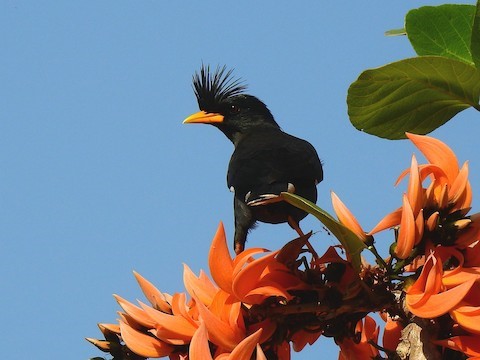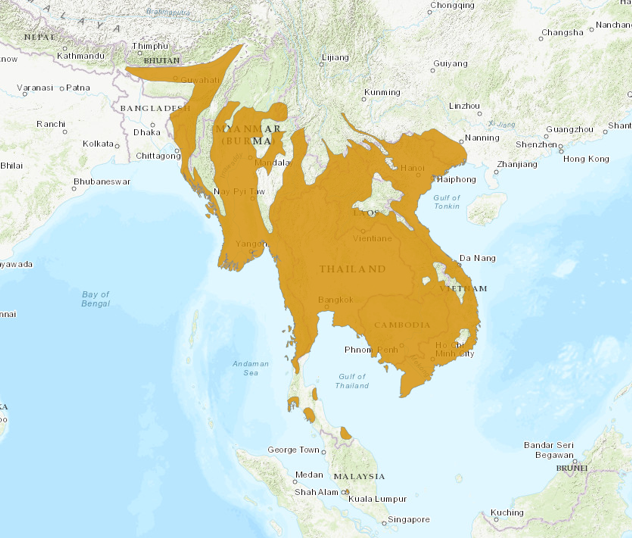Birdfinding.info ⇒ Common and conspicuous in Assam and throughout the lowlands of Thailand and western Cambodia. Among the most familiar city birds in Bangkok. Fairly common in city parks of Kuala Lumpur, including Taman Tasik Perdana. Uncommon and localized elsewhere in its range.
Great Myna
Acridotheres grandis
Southeast Asia. Mainly in humid open and semiopen habitats, including cities and agricultural areas.
From eastern India (west to West Bengal), northern Myanmar, Laos, and northern Vietnam (locally or sporadically into southern China in Yunnan and Guangxi) south throughout Indochina and down the Malay Peninsula to the Malaysian border area, with a disjunct population farther south in the vicinity of Kuala Lumpur.
Identification
A medium-large, black myna with a bushy frontal crest, white undertail, and white wing-patches across the bases of the primaries.
The bill and legs are bright yellowish-orange, and the eyes are dark reddish-brown.
Viewed from above, the tail is black with a white terminal band and edges.
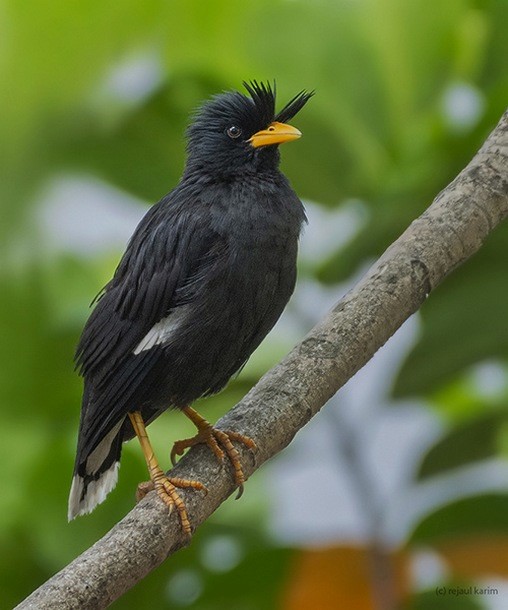
Great Myna, showing white undertail. (Guwahati Medical College Campus, Kamrup Metro District, Assam, India; April 17, 2020.) © Rejaul Karim
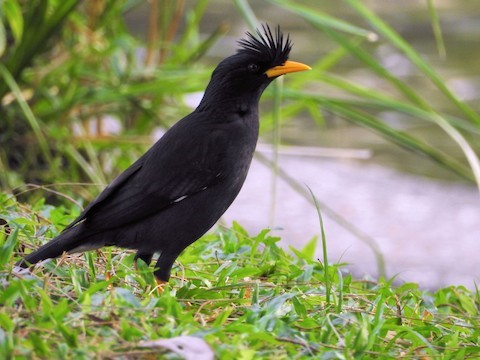
Great Myna, appearing mostly black at this angle. (Lumphini Park, Bangkok, Thailand; December 24, 2015.) © Tim Norris
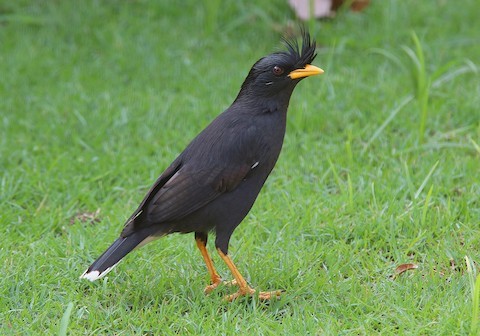
Great Myna, appearing mostly black with white-tipped tail. (Rama Public Park, Phra Nakhon Si Ayutthaya, Thailand; March 7, 2019.) © Tim Avery
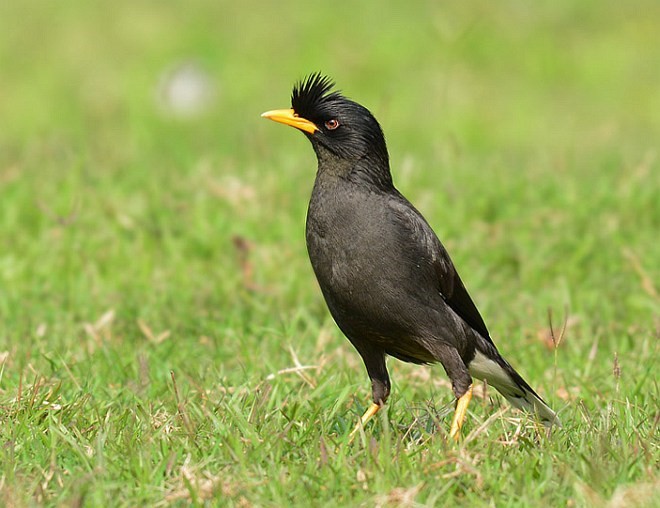
Great Myna. (Tinsukia, Assam, India; March 6, 2016.) © Mayuresh Khatavkar

Great Myna, showing white undertail. (Jalpaiguri, West Bengal, India; January 18, 2010.) © Amit Thakurta
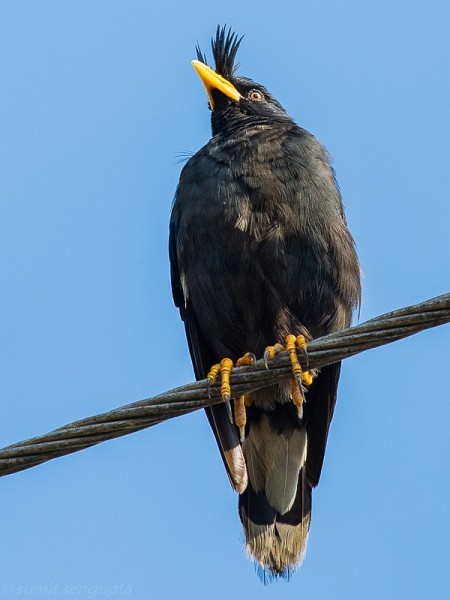
Great Myna, showing mostly white undertail while moulting—some feathers heavily worn and others new. (Guwahati, Assam, India; September 13, 2014.) © Sumit Sengupta
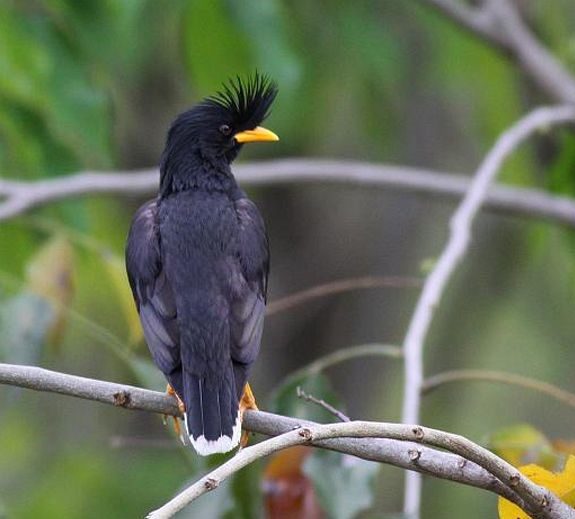
Great Myna, showing typical uppertail pattern: black with white tip and edges. (Bangsar, Kuala Lumpur, Malaysia; February 28, 2011.) © Pathmanath Samaraweera
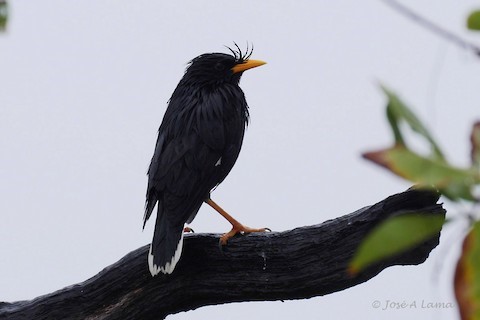
Great Myna, with crest wet and showing typical uppertail pattern: black with white tip and edges. (Pak Thale, Phetchaburi, Thailand; January 9, 2017.) © José Antonio Lama

Great Myna, with an unusually broad white tail band. (Rama Public Park, Phra Nakhon Si Ayutthaya, Thailand; March 7, 2019.) © Tim Avery
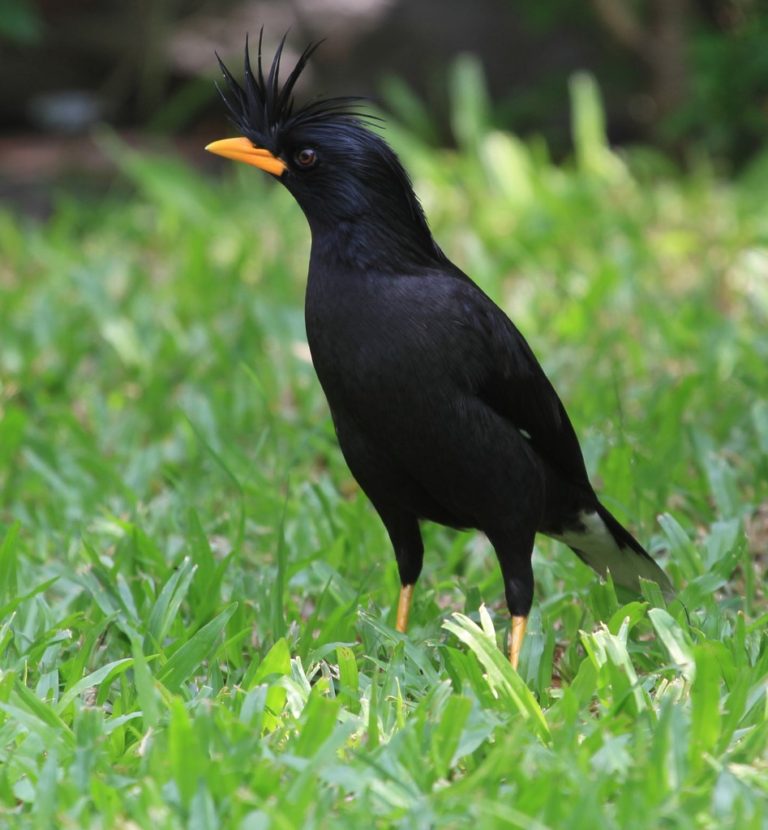
Great Myna, an individual with an exceptionally long crest. (Rommaninat Park, Bangkok, Thailand; November 22, 2014.) © Ingeborg van Leeuwen
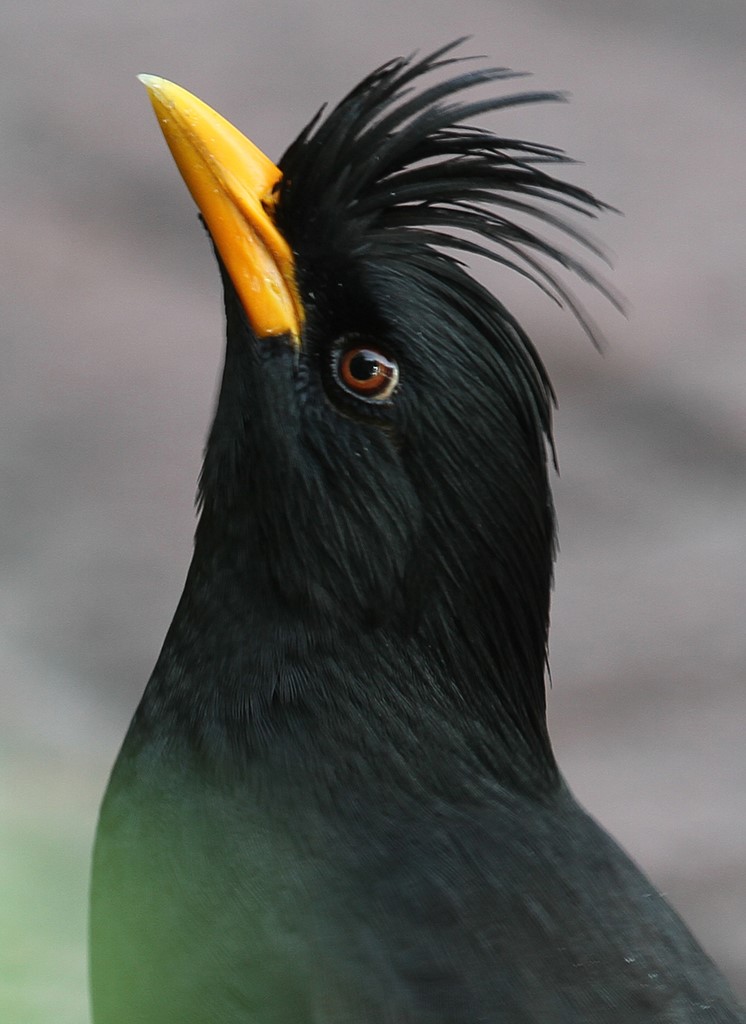
Great Myna, an extraordinarily detailed view of its bill, crest, and eye. (Suan Saranrom Park, Bangkok, Thailand; November 23, 2014.) © Ingeborg van Leeuwen
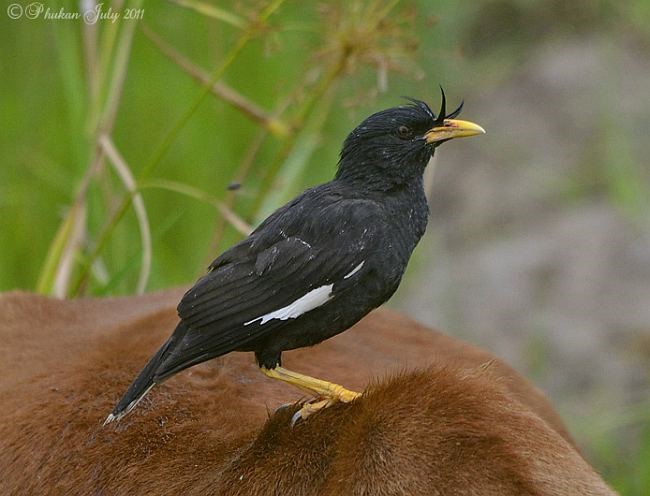
Great Myna, riding a large mammal. (Digboi, Assam, India; July 17, 2011.) © Raj Kamal Phukan

Great Myna, riding a large mammal. (Barpeta, Assam, India; December 10, 2015.) © Rejaul Karim
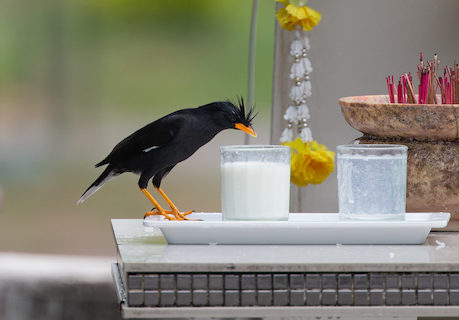
Great Myna, taking breakfast. (Amphoe Ban Laem, Phetchaburi, Thailand; November 23, 2018.) © Robert Tizard

Great Myna, showing its white wing-patches. (Roing, Arunachal Pradesh, India; February 26, 2016.) © Sujata Shashank Phadke

Great Myna with its crest fully fanned out, and showing broad white terminal band on tail. (Ban Khum, Phetchaburi, Thailand; May 17, 2018.) © Simon Best
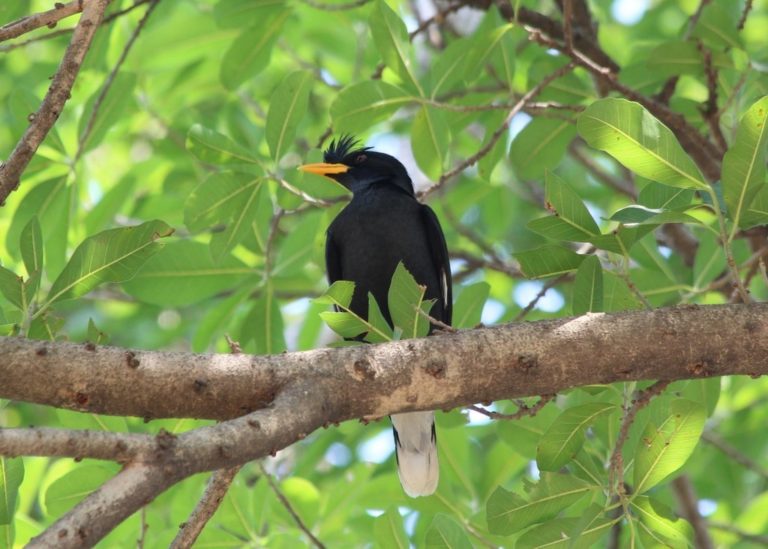
Great Myna, showing white undertail. (Bangkok, Thailand; February 23, 2019.) © Jessica dos Anjos
Immatures generally resemble adults but have shorter crests and brownish wings.
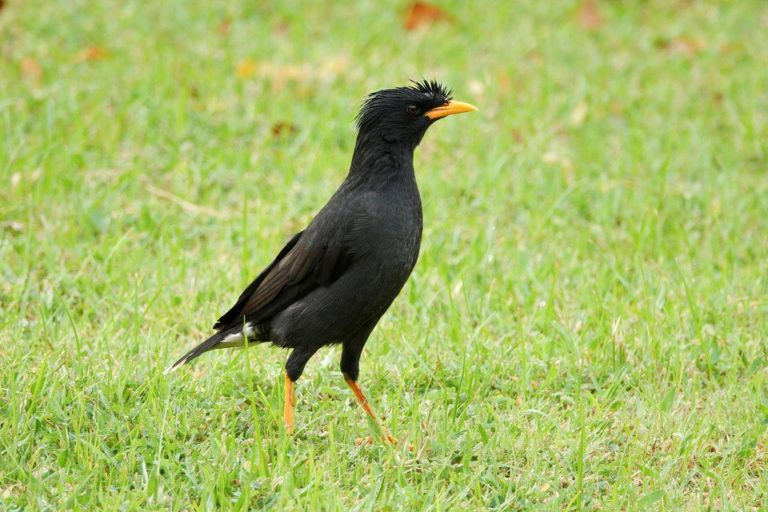
Great Myna, immature—note short crest and brownish wings. (Hat Chao Samran, Phetchaburi, Thailand; October 8, 2018.) © CheongWeei Gan
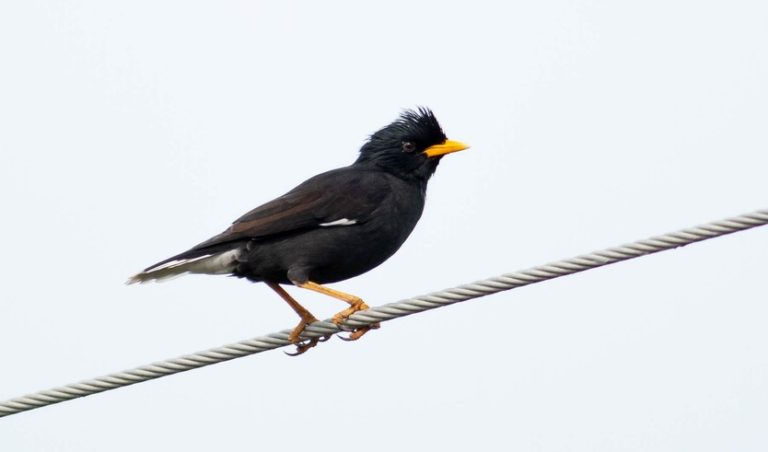
Great Myna, immature—note short crest and brownish wings. (Sala Lai, Sam Roi Yot, Prachuap Khiri Khan, Thailand; November 7, 2018.) © Paul Fenwick
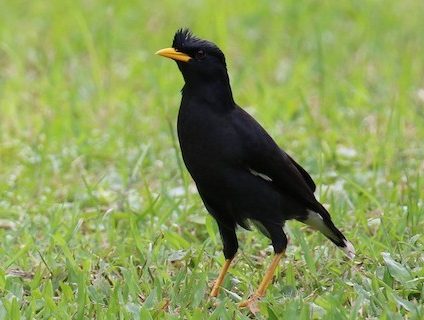
Great Myna, likely immature—with short crest, similar to the of a Crested Myna. (Lumphini Park, Bangkok, Thailand; March 11, 2018.) © Jens Toettrup
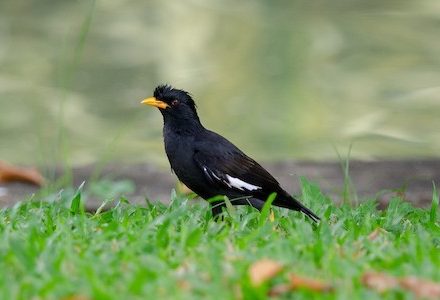
Great Myna, immature—note short crest and brownish wings. (Lumphini Park, Bangkok, Thailand; November 4, 2019.) © Sergo Travelian

Great Myna, showing shape and position of white wing-patches, and white corners on tail. (Roing, Arunachal Pradesh, India; February 26, 2016.) © Sujata Shashank Phadke
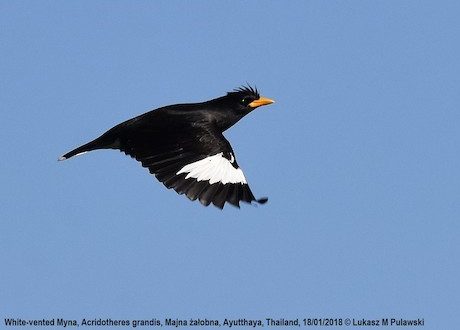
Great Myna, showing shape and position of white wing-patches. (Krung Sri Thani, Phra Nakhon Si Ayutthaya, Thailand; January 18, 2018.) © Lukasz Pulawski

Great Myna, showing shape and position of white wing-patches. (Tambon Bang Chak, Chang Wat Phetchaburi, Thailand; January 16, 2019.) © Joachim Bertrands

Great Myna, showing shape and position of white wing-patches, and white corners on tail. (Barpeta, Assam, India; September 29, 2015.) © Rejaul Karim

Great Myna, showing shape and position of white wing-patches. (Tambon Bang Chak, Chang Wat Phetchaburi, Thailand; January 16, 2019.) © Blair Dudeck
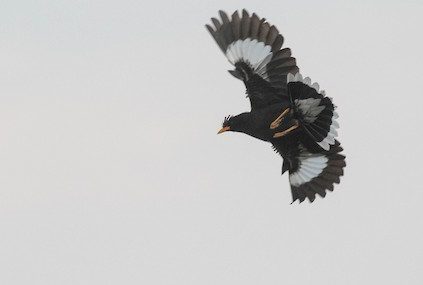
Great Myna, ventral view of fully spread wings and tail, showing actual proportions of tail feather tips that are white. (Shan-Inle Lake, Shan, Myanmar; March 3, 2020.) © Doug Gochfeld
Cf. Other Acridotheres Mynas. Great is one of six Acridotheres mynas that share the same basic features: gray-to-black overall with white wing-patches and bushy frontal crests. Four of these are common and widespread and have partially overlapping ranges, due largely to introductions: Great (grandis); Crested (cristatellus); Javan (javanicus); and Jungle (fuscus). The other two are more localized and have more distinctive coloration, as their names suggest: Pale-bellied (cinereus) is endemic to Sulawesi; and Collared (albocinctus) occurs mainly in northern Myanmar.

Great Myna. (Tinsukia, Assam, India; March 6, 2016.) © Mayuresh Khatavkar

Crested Myna. (Penang Botanical Gardens, Pulau Pinang, Malaysia; January 14, 2019.) © Neoh Hor Kee
Among the four widespread bushy-crested mynas, Great is distinctive in several ways: (1) the blackest overall; (2) the most sharply contrasting white undertail; (3) the longest crest; (4) darkest eyes; (5) bright yellow-orange bill and legs.
Overall Coloration: The base color of the body plumage differs somewhat, but also varies within species. Typically: Great is close to jet-black; Crested tends to show some gray tones; Javan is dark slaty-gray with a blacker hood; and Jungle is medium slaty-gray with some brown tones and a much blacker hood.
Tail and Vent Color: Crested’s undertail coverts and tail feathers are narrowly tipped with white, whereas the other species have mostly white undertail coverts and extensively white tail feathers. Great typically appears jet-black otherwise, so the white in its tail contrasts sharply.
Crest Shape: Crest shape may be helpful in some cases, but it is often ambiguous because all four species can have short crests. Typically, Great’s crest is longer and spikier than any of the others, and Crested has the next-longest crest feathers. Javan and Jungle’s crest-feathers are always shorter than typical Great and Crested.
Eye Color: Although eye color is somewhat variable and less reliable than the other features, it can be helpful for confirmation. Crested’s is roughly intermediate between Great and the other two. Great’s eyes usually appear dark-brown, or reddish when illuminated. Javan and Jungle usually show pale-yellow or whitish eyes, sometimes bluish-white. Crested’s eyes are consistently medium-orange, paler than Great’s and darker than Javan and Jungle’s.
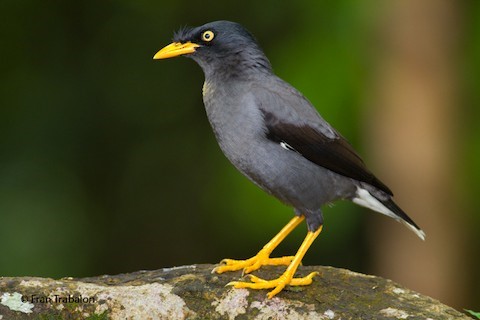
Javan Myna. (Bukit Timah, Singapore; November 15, 2011.) © Fran Trabalon
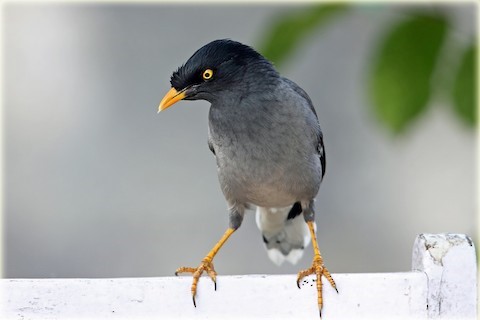
Jungle Myna. (Kathmandu, Nepal; October 7, 2014.) © John Thompson
Bill and Leg Color: Great, Javan, and Jungle Mynas all have matching yellowish-range bills and legs—although Jungle differs in that its bill is strongly bicolored, with a black base. Crested’s bill is pale greenish-yellow (or ivory or “horn-colored”) and its legs are orange, sometimes bright and sometimes dark. The colors of both its bill and its legs differ from those of the others, and they differ from one another.
Notes
Monotypic species.
Historically also known as the White-vented Myna, but this name was also regularly applied to the Javan Myna (A. javanicus), so old references to White-vented are ambiguous due to failure to distinguish between the two species.
References
BirdLife International. 2016. Acridotheres grandis. The IUCN Red List of Threatened Species 2016: e.T103871222A94268442. https://dx.doi.org/10.2305/IUCN.UK.2016-3.RLTS.T103871222A94268442.en. (Accessed April 30, 2020.)
Craig, A., and C. Feare. 2020. Great Myna (Acridotheres grandis). In Handbook of the Birds of the World Alive (J. del Hoyo, A. Elliott, J. Sargatal, D.A. Christie, and E. de Juana, eds.). Lynx Edicions, Barcelona. https://www.hbw.com/node/60867. (Accessed April 30, 2020.)
eBird. 2020. eBird: An online database of bird distribution and abundance. Cornell Lab of Ornithology, Ithaca, N.Y. http://www.ebird.org. (Accessed April 30, 2020.)
Feare, C., A. Craig, B. Croucher, C. Shields, and K. Komolphalin. 1999. Starlings and Mynas. Princeton University Press, Princeton, N.J.
Robson, C. 2002. Birds of Thailand. Princeton University Press, Princeton, N.J.
Xeno-Canto. 2020. Great Myna – Acridotheres grandis. https://www.xeno-canto.org/species/Acridotheres-grandis. (Accessed April 30, 2020.)
